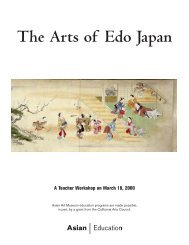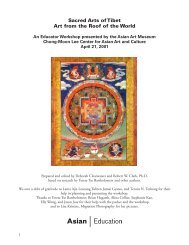Teacher Packet: Chinese Brushpainting (.pdf) - Asian Art Museum ...
Teacher Packet: Chinese Brushpainting (.pdf) - Asian Art Museum ...
Teacher Packet: Chinese Brushpainting (.pdf) - Asian Art Museum ...
Create successful ePaper yourself
Turn your PDF publications into a flip-book with our unique Google optimized e-Paper software.
Slide 14<br />
Brushstrokes: Styles and Techniques of <strong>Chinese</strong> Painting<br />
Flowering Plants and Trees<br />
Chen Chun (1483-1544)<br />
Ming dynasty, dated 1537<br />
Handscroll, ink and colors on paper<br />
B70 D4b<br />
Birds and Flowers comprised one of the major categories of <strong>Chinese</strong> painting and, like Landscapes and<br />
Figure Painting, was represented by two major stylistic divisions: a carefully painted, colorful, realistic<br />
style (gongbi); and an expressionistic, predominantly ink style, called xieyi or idea writing.<br />
In this painting, Chen Chun has arranged the branches of flowering plants and trees in a loosely<br />
structured composition. The plants bend and sway pointing to and from each other in a sort of<br />
rhythmic dance. Chen's interest in linear rhythms is underscored by the inclusion of short poems<br />
within the fabric of the composition. Poetry, painting, and calligraphy, the Three Perfections are all<br />
fully integrated.<br />
The picture is not so much a group of botanical specimens as a poetic expression of the beauties of<br />
nature. Chen captures the personality, you might say, of each plant with his brushwork. Plum is stiff<br />
and thorny with fragile flowers clustered close to the stem while camelia stems curl under the weight<br />
of their heavy flowers and dense leaves. The dense, dark foliage of pine and cypress is expressed in<br />
dashes and dots of ink and color.<br />
Chen uses several types of brushwork in this painting (see Chart B), including the two techniques<br />
of baimiao (outline method) and mogu (boneless technique). He uses color always in the boneless<br />
manner, such as in the camelia flowers where one or two strokes of color wash is enough to suggest<br />
each of the petals. There are no outlines nor carefully controlled layers of color. On the other hand,<br />
the baimiao technique seen in the painting of the narcissus and plum flowers, consists of outlines<br />
exclusively. Bamboo is a special plant to the scholar-painter. It is a symbol for the scholar-gentleman<br />
who bends but does not break in the wind, and the painting of it is a regular exercise in xieyi<br />
brushwork. Single strokes of the brush held at an angle form the leaves and darker, drier strokes form<br />
the jointed bamboo stems.<br />
17 <strong>Asian</strong> <strong>Art</strong> <strong>Museum</strong>
















